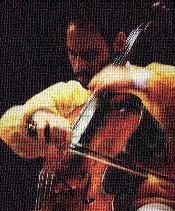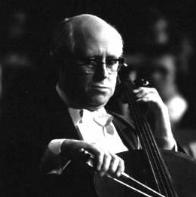MASTER CLASS REPORTS --
JANOS STARKER'S 75TH
BIRTHDAY CELEBRATION
by Tim Finholt
The following are my notes from the master classes in Bloomington, Indiana during the 75th Birthday celebration for Janos Starker (September 12-14, 1999). Please note that, though certain ideas are discussed in terms of specific points in the music, some ideas may be applied in a more general sense.
Maria Kliegel's Master Class |
Maria Kliegel
 |
Bach c minor Prelude
- The dotted notes shouldn't come out like triplets (i.e. m. 8).
- It is important that one learn about Baroque performance practice.
- Come in on the opening C's with confidence, though not necessarily with a bang.
- The G in measure 1 continues what the C is doing, so be sure to connect it to the previous C.
- One gets better articulation in the dotted eighth-sixteenth passages (i.e. m. 6) if one slightly re-takes the bow on the sixteenth notes. Let the bow swing. Be sure to articulate with the left hand too.
- Direct the phrases towards the important chords. Play longer phrases. Do not over-emphasize the smaller moments.
- If you start the fugue at the tip (m. 27), be sure to articulate the opening eighth notes.
- Lead the measures to the first beats of each measure of the fugue.
Prokofiev Sinfonia Concertante
- Be sure to maintain a sense of power in the upper half of the bow. Don't let go of the "pressure."
- Connect the B to the high C# with strong vibrato (m. 15). Don't lose the sense of connection and intensity in the shift.
- Double-stops with C and G strings (m. 39) -- swing the whole body as you play each bow. Use your entire body weight.
- The music always should lead us to the necessary technique. Trust yourself.
Haydn D Major Concerto
- Be sure to breathe with the bow. Let the strings ring.
- Music is like a language and life ... full of risks.
- Maria Kliegel plays the opening F# (m. 29) with the first finger. The third finger doesn't make sense musically, since the change from 3 to 1 is audible.
- If music demands risk, do it. If it doesn't, find the easiest fingering.
- Descending chromatics (m. 30) -- possible bowing starting with D is Up-Down-Up-Up-Up, instead of trying to do them all on one upbow staccato.
- Two upbow eighth notes (m. 32) -- Do a slight retake of the bow and let the string ring in between.
- B to F# to D (m. 36) -- Connect the B to the F# and then release the thumb so you can vibrate.
- Sextuplets (m. 41 and m. 43) -- Play the first set strong (male) and the second time delicate (female).
Dvorak Cello Concerto
- Don't lose the sound between the opening B and the C#.
- Chords (triple stops) -- Pull with the bow and vibrate. Don't overpress.
- Cadenza (before #4 in the International Edition) -- Play a little more slowly when you reach the C and G strings since these strings take a little longer to speak.
- Cadenza (12 before #4 in the International Edition). -- Maria Kliegel goes to the C string as soon as possible so that she can lay into the C string heavily without worrying about hitting other strings with the bow.
- It's easier to slide the hand more accurately back up the fingerboard (towards the scroll) in thumb position if it isn't in a closed position.
Gary Hoffman's Master Class |
Gary Hoffman
 |
Lalo Cello Concerto
- Don't avoid the fourth finger.
- In the opening (m. 9-m. 14), you need to fill in the gaps between the important structural notes, and think about how you are going to accomplish this.
- In the opening (m. 9-m. 14), timing is key. You need to come in anywhere but where one expects you to. It's a recitative.
- Think of the overall shape of the notes, not just individual notes.
- Don't bang the C-string such that it hits the fingerboard. You will get more sound with a horizontal attack than with a vertical one.
- "Sustain" doesn't mean to play flat and evenly. It means to build or decay naturally with the phrase.
- Don't let the elbow dip at the frog if you want a sustained sound.
- We have to give the illusion of dynamic contrast through intensity of sound, not necessarily through changes in volume.
- Don't neglect vibrato on the small notes.
- Don't be afraid to try things that will surprise you.
- Sextuplets (m. 111) -- Don't over-lift the fingers. You will gain security and speed if you don't lift too high. Think more about the bow.
- In fast notes (m. 111, etc.), don't rotate the wrist so far back that you don't have time to bring fingers back down. The fingers should be lifted no higher than necessary.
- Approach the fingerboard from above, with controlled arm weight, not from below.
Bach D Major Prelude
- "The worst thing in Bach is to be afraid of it."
- The preludes are opportunities for more improvisational playing. They are not meant to be played in a strict pulse. Look for opportunities for variety and for a natural push and pull in the motion.
- The first note is important because it sets the tone for the rest of the piece, like "a stone dropped into water, with impulses that ripple through the rest of the work." Don't come in weakly.
- G in measure 5 -- You don't need to vibrate the G since it is a repeated note and is emphasized with repetition already.
- Cadenza (m. 85) -- Don't neglect the A harmonic with the bow.
- Final chords (m. 98) -- Voice the chords like a pianist, bringing out the bottom line where the motion is. The upper D is already heard easily.
Tchaikovsky Pezzo Capriccioso
- Don't play the first note with a big bang.
- Don't create variety by just changing the volume. Change the tone with bow expression and a variety of articulations and vibratos.
Beethoven A Major Sonata
- Play the opening phrasing with a longer sense of line in mind (m. 1, etc).
- If you vibrate the opening phrase too heavily (m. 1, etc), it can make the pianist's octaves that follow in measure 13 sound too bare.
- Try to maximize expression with the bow and without vibrato. Only add slight vibrato if necessary. "This music needs no make-up." Play simply in the beginning.
- Pizzicato (m. 66) -- This part was originally written as bowed triplets.
Mstislav Rostropovich's Master Class |
Rostropovich
 |
Beethoven C Major Sonata
- You must make music as if it is being composed as you play, including the piano part.
- Opening (m. 1) -- peaceful, quiet, "good morning." Have C Major inside you before you play.
- Always tune before you go out on stage. People come to hear Beethoven, not a composition based on perfect fifths.
- Start the bow motion in the tempo of the music before you touch the string with the bow (m. 1), like a conductor. This applies to any entrance.
- Rostropovich likes to imagine the circumstances in which a piece was composed. He imagines that the Brahms e minor Sonata was written when it was raining.
- Quiet kiss good-bye at the end of the opening (pizzicato in m. 27).
- Imagine an army general in the beginning of the next section (m. 28).
- Don't change positions between fast notes if you don't have to, change between longer notes.
Rococo Variations
- The original rococo style included the creation of elegant decorations made of sea shells and lace. Instead of this, the student seemed to be making decorations from "bottles of Coca Cola."
- "You don't make lace. You make Toyotas."
- Variation III -- The cadenza leading up to this movement leads to c minor, but goes to C Major instead. "All of a sudden there is lightness and beauty."
- One must continuously vary one's vibrato, ranging from a "sweet lady or a lyrical tenor to a strong and powerful tenor."
- Variation IV -- Descending chromatic spiccato scale (m. 17). "Don't play it as if pulling a worm out of the ground." Be sure to play it in time so that the important notes land on the appropriate beats.
- Variation V -- Listen for the melody in measures 1-8. The trills are not that important. Practice this part while whistling the melody.
- Variation VI-- Play the ending without vibrato the first time (m. 23-29), then with vibrato (m. 30-31).
- Variation VII -- To play fast spiccato, be sure that the frog moves in more of a circular motion rather than just back and forth.




